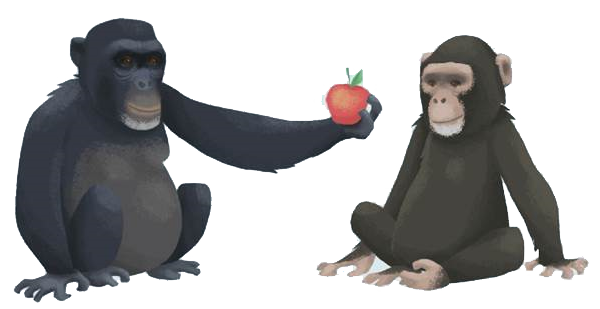عبارت علمی شماره دو
اخلاق منحصر به نوع بشر نیست: عناصر آن را میتوان در روابط دیگر حیوانات نیز مشاهده کرد

بسیاری معتقدند که گونه ما اخلاق را به شکلی انحصاری از خدا یا خدایان دریافت کرده است.آیا اینگونه است؟
قطعا این دیدگاه به شکلی گسترده مورد قبول است، با این حال حقایق این باور نادرست را پشتیبانی نمیکنند.
با مشاهدات دانشمندان، ما شروع به درک این موضوع کرده ایم که انسان یا همان هوموساپینس، تنها یکی از گونه ها در میان انبوه جاندارانی است که ذاتا دارای اخلاق است.
تعاملات اجتماعی پستانداران دبگر بغییر از انسان را در نظر بگیرید، بیش از 90 درصد این تعاملات بیش از انکه رقابتی و واگرایانه باشد همگرا و تعاونی است.
برخی دیگر از نمونه های رفتار اخلاقی:
- میمونهای دیانا برای به دست اوردن غذا به هم کمک میکنند.
- گله ای از فیلها درب محوطه را باز میکنند تا به بزهای کوهی برای فرار کمک کنند.
- گربه ای به نام لیبی دوست سگ کر و کور خود را هدایت میکند تا از موانع گذر کرده و به غذا برسد
- زمانی که موشی در قفس مشاهده میکند که در نتیجه فشار اهرمی که او را به غذا میرساند به موش قفس کناری شوک الکتریکی وارد میشود دیگر اهرم را فشار نمیدهد.
همانطور که اشاره شد رفتار شناس مارک بکوف خاطر نشان میکند که : ما تنها ساکنین عرصه اخلاق نیستیم.
کمک، همکاری و مراقبت صفات منحصر به فرد مخصوص انسان که ان را از متون مقدس و خدایانان به دست اورده باشد نیستند. نزدیکترین خویشاوندان ما شامپانزهها ( که 98 درصد از ژنهایمان با هم مشترک است) نیز همین ویژگیهای رفتاری را نشان میدهند. چنین ویزگیهای به اشتراک گذاری شده و تکامل یافته در یک نسب فنوژنتیک با هم یکی میشوند.
این ویژگیها حتی در گونه های که دور از ما در درخت تکاملی جای میگیرند نیز مشاهده شده است.
| عبارت شماره یک | عبارت شماره سه |
منابع
- Aureli, F., & de Waal, F. B. M. (Eds.). (2000). Natural conflict resolution. Berkeley: University of California Press.
- Axelrod, R., & Hamilton, W. (1981). The evolution of cooperation. Science, 211, 1390-1396.

- Brosnan, S. F., & de Waal, F. B. M. (2003). Monkeys reject unequal pay. Nature, 425, 297–299

- Chen, K. & Hauser, M.D. (2005). Modeling reciprocation and cooperation in primates: Evidence for a punishing strategy. Journal of Theoretical Biology, 235, 5-12.
- Church, R. M. (1959). Emotional reactions of rats to the pain of others. Journal of Comparative and Physiological Psychology, 52(2), 132.
- Crespi, B. J. (2001). The evolution of social behaviour in microorganisms. Trends in Ecology & Evolution, 16(4), 178-183.

- De Waal, F. B. (2008). Putting the altruism back into altruism: The evolution of empathy. Annual Review of Psychology, 59, 279-300.

- De Waal, F. B., Leimgruber, K., & Greenberg, A. R. (2008). Giving is self-rewarding for monkeys. Proceedings of the National Academy of Sciences, 105(36), 13685-13689.

- Hamilton, W. D. (1963). The evolution of altruistic behavior. The American Naturalist, 97, 354-356.

- Harcourt, A., & de Waal, F. B. M. (Eds.). (1992). Coalitions and alliances in humans and other animals. Oxford: Oxford University Press.
- Maynard Smith, J., & Price, G. R. (1973). The logic of animal conflict. Nature, 246, 15-18.

- Melis, A., & Tomasello, M. (2013). Chimpanzees’ strategic helping in a collaborative task. Biology Letters, 9, 2013.

- Melis, A.P., Warneken, F., Jensen, K., Schneider, A.C., Call, J., & Tomasello, M. (2011). Chimpanzees help conspecifics obtain food and non-food items. Proceedings of the Royal Society B, 278(1710), 1405-1413.

- Meloni, M. (2013). Moralizing biology: The appeal and limits of the new compassionate view of nature. History of the Human Sciences 26 (3), 82-106.

- Pierce, J., & Bekoff, M. (2012). Wild justice redux: What we know about social justice in animals and why it matters. Social Justice Research, 25(2), 122-139.

- Range, F., Leitner, K., & Virányi, Z. (2012). The influence of the relationship and motivation on inequity aversion in dogs. Social Justice Research, 25(2).
- Sussman, R. W., Garber, P. A., & Cheverud, J. M. (2005). Importance of cooperation and affiliation in the evolution of primate sociality. American Journal of Physical Anthropology, 128(1), 84-97.

- Trivers R.L. (1971.) Evolution of reciprocal altruism. Quarterly Review of Biology, 46, 35-57.

- Trivers, R. L. (1985). Social evolution. Menlo Park, California: Benjamin/ Cummings.
- Warneken, F. (2013). The development of altruistic behavior: Helping in children and chimpanzees. Social Research, 80(2), 431-442.

- Warneken, F., & Tomasello, M. (2009). Varieties of altruism in children and chimpanzees. Trends in Cognitive Sciences, 13(9), 397-402.

- Warneken, F., & Tomasello, M. (2006). Altruistic helping in human infants and young chimpanzees. Science, 2006, 1301-1303.

- Warneken, F., Chen, F., & Tomasello, M. (2006). Cooperative activities in young children and chimpanzees. Child Development, 77 (3), 640-663.



